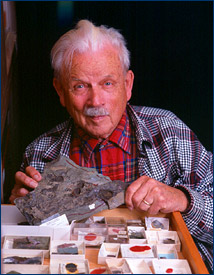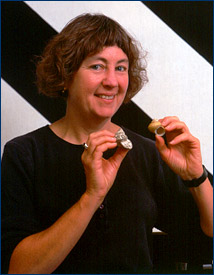
John Wyatt Durham taught at Cal from 1947 to 1975. Both of the photos on this page were taken in the 1980s. Click on either image to see an enlargement.
Architects of the Berkeley legacy of Cenozoic molluscan paleontology - part II
by Carole S. Hickman
* See Part I of this article in the September 2008 UCMP News. *
 John Wyatt Durham taught at Cal from 1947 to 1975. Both of the photos on this page were taken in the 1980s. Click on either image to see an enlargement. |
Durham's most influential student in Cenozoic molluscan paleontology was Warren Oliver Addicott (Ph.D. 1956), whose career with the Paleontology and Stratigraphy Branch of the U.S. Geological Survey in Menlo Park set new standards for monographic systematics, faunal and biostratigraphic documentation, and photographic illustration as well as initiating new insights and integration of molluscan research with active margin tectonics, refined climate curves, latitudinal distributions based on marine mollusks, increased radiometric age control on molluscan faunas, extension of molluscan paleontological interpretations into Alaska, and fostering exchange and collaboration with Japanese molluscan paleontologists.
Durham's own research turned increasingly away from mollusks to echinoderms and from the Tertiary Period to the Early Cambrian; however, he encouraged his students in the study of living as well as fossil mollusks. Many of his twenty-nine students established new research frontiers. John James Oberling (M.A. 1951, Ph.D. 1955) and Copeland MacClintock (Ph.D. 1964) conducted some of the first detailed analyses and characterization of molluscan shell structure. And studies of the ecology of modern near-shore mollusk communities by Elton Linwood Puffer (M.A. 1953) and William Keith Emerson (Ph.D. 1956) were among the first to recognize that modern communities (biofacies) and their corresponding environments (biotopes) would become keys to understanding the geologic record of climate change.
Durham's participation as an expedition leader in the landmark 1940 Scripps Cruise to the Gulf of California stimulated intense interest in integrative studies of faunas, environments, and geology. This and other large projects generated abundant research opportunities as well as funding (e.g., Scripps Institution of Oceanography, Geological Society of America, American Petroleum Institute) for his students.
No account of the Durham era would be complete without acknowledging the contributions of his Berkeley colleague, Senior Museum Scientist Joseph H. Peck, Jr. Durham's legacy of research and mentoring of students is matched by Peck's legacy of curation and growth of the mollusk collections. One of the most intriguing events was the 1950 discovery and purchase of a famous 19th century French collection containing 1,936 correctly-identified species of Eocene fossil mollusks from the Paris Basin, their removal from the estate of Dr. Charles Louis Cloez, and their arrival in Berkeley. The history of this collection is still shrouded in mystery. Peck discovered that it contained 68 type specimens, now in the UCMP type collection.
 In 1978, Carole Hickman became the first woman faculty member in the paleontology department. |
At the time of his retirement in 1975, Durham had set the stage for new molluscan research at Berkeley that would further diversify to include actualistic paleoecological studies, identification and designation of recurring Cenozoic molluscan communities, constructional morphological analysis of molluscan features, a new method of molluscan paleobathymetric interpretation, studies of the taphonomic information content of the molluscan record, biological interpretations based on the molluscan larval shell, development of new character sets for cladistic analyses of living and fossil mollusks, recognition and interpretation of chemosymbiotic molluscan cold-seep assemblages, inclusion of molecular data in molluscan phylogenetic analyses, reinterpretation of the Eocene-Oligocene mass extinction and greenhouse-icehouse climatic transition, experimental analyses of mollusk-substrate interactions, studies of the changing roles of mollusks in Pacific Coast intertidal communities, and revision of the higher level systematics and phylogenetic relationships of marine mollusks.
The collections of Cenozoic mollusks in the Museum of Paleontology continue to grow, in spite of increasingly severe space constraints. Rescue by the Museum and UC Regents of the Tertiary mollusk collections from the U.S. Geological Survey in Menlo Park carries a significant burden of responsibility as well as marvelous new opportunities. Dissolution of the Paleontology and Stratigraphy Branch and demise of basic research at the Survey has been recognized in the paleontological community as a "scientific disaster of epic proportions." The Berkeley challenge is to expand as well as maintain its unparalleled molluscan paleontological collections and to appoint new faculty and curators who will continue to train students and postdoctoral scholars, foster new collaborations and vision, and expand this remarkable legacy.
Durham and Hickman photos from the UCMP Archives.